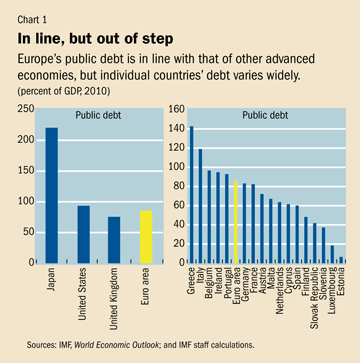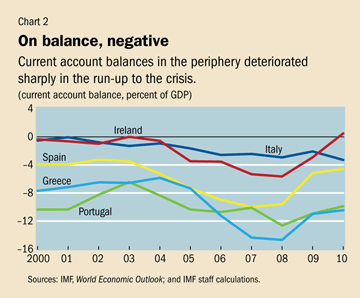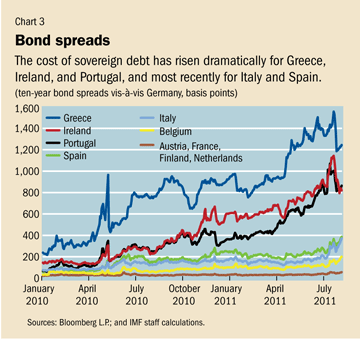More Europe, Not Less
Finance & Development, September 2011, Vol. 48, No. 3
The euro area is learning from its debt crisis that it needs a more centralized approach to fiscal and financial policies

WHEN it comes to sovereign debt, the euro area seems to be different. Even with a level of debt in line with that of other advanced economies, it has been engulfed in a sovereign debt crisis (see Chart 1). True, the euro area is not a single nation, and its treaty prohibits member states from sharing each other’s liabilities. But why should that mean that one member’s troubles mean trouble for all and investors fret about the future of the economic and monetary union?

Looking back at the causes of the debt crisis in Europe, we conclude that incomplete economic, financial, and fiscal integration is part of the answer. To function effectively, the economic and monetary union will require some form of fiscal risk sharing, tighter monitoring of national policies, and an integrated pan-European approach to its financial system. Progress is being made on all these fronts, but rapid implementation remains of the utmost importance.
Conspiracy of factors
The Economic and Monetary Union (EMU) was founded on the premise that the benefits of a common currency would outweigh the costs of relinquishing national currencies. The plan envisaged in the Stability and Growth Pact (SGP) was to have European institutions keep a close eye on countries’ budgets via annual evaluations and to create enough fiscal discipline to leave room to deal with country-specific shocks. The coordination of national product and labor market reforms (for instance, opening up the electricity market or encouraging labor market participation) would align economies so that they would react more similarly to common shocks.
However, with the introduction of the EMU, southern euro area countries and Ireland (loosely referred to as the periphery) experienced a very specific shock: they witnessed a dramatic decline in borrowing costs after many years of much higher interest rates than their northern counterparts. This allowed firms to finance their productive investment more cheaply and expand—certainly a welcome development. But it also led to a widespread belief that strong growth would be permanent. Households assumed they could afford much higher living standards, leading to credit-led buying sprees and real estate bubbles. And governments—along with their creditors—took for granted the revenues generated by the growth spurt, failing to save the debt-service savings brought about by the drop in interest rates.
Meanwhile, because the common currency eliminated cross-border transaction costs, financial integration within the euro area flourished—another benefit of the EMU. But inflows to countries in the periphery came mostly in the form of debt to banks, making them increasingly reliant on funding raised in the markets (which is called wholesale funding), rather than on bank deposits, to finance domestic credit. Conversely, equity flows—such as from cross-border mergers and acquisitions, where risks are shared and hence better monitored by investors—were small.
National financial supervisors fell under the same optimistic spell. They became complacent about rising credit risks and allowed banking systems to grow disproportionately to the size of the economy. As a result, the risk grew that the banking sector would become increasingly unaffordable for governments to support in a financial crisis. In the absence of a pan-European supervisory body, risks related to the growing interconnectedness of national financial systems through large cross-border loans to banks were overlooked.

Readily available intra–euro area financing made it easy to dismiss diverging trends in competitiveness. While Germany and neighboring euro area countries were retooling their production model by integrating eastern Europe into their supply chains to compete with lower-cost manufacturing powerhouses in Asia, countries in the periphery seemed oblivious to rising costs, as overheating led to large wage increases. For a long time, policymakers and foreign private investors alike ignored the fact that the dramatic deterioration in the periphery countries’ external position was financing mostly unproductive spending (for example, real estate investment), so that the accumulating debt could prove hard to pay back (see Chart 2).
Hard landing
Until the euro area came into existence, sovereign debt problems were primarily external debt problems. The nominal value of domestic debt could usually be preserved, albeit often at the cost of a bout of inflation. With the establishment of the euro area, this mechanism disappeared. Member countries’ domestic and external debt were indistinguishable and there was no (domestic) central bank to inflate problems away.
The opposite is also true, however. In the euro area, countries retained control over fiscal policy and there was no common euro area treasury, including to back the European Central Bank’s operations. The founders of the euro area were very much aware of the need to preserve fiscal discipline, and counted on a combination of administrative tools (the SGP) and market discipline. But both mechanisms were eroded: the SGP was watered down and markets fell asleep at the wheel. The plan worked well during good times, but fell apart when the global crisis hit.
The fall of the U.S. investment bank Lehman Brothers in October 2008 set the stage for a dramatic reversal of fortune in the euro area. Operations of wholesale funding markets came to a sudden halt, making it harder for banks in the periphery to continue financing credit-driven growth.
Once credit dried up, fundamental competitiveness problems and structural impediments to growth came to the fore, particularly in Greece and Portugal. Fiscal revenue dried up, revealing weak underlying public finances. Private investors started scrutinizing deteriorating balance sheets, and ailing banks increasingly needed fiscal support, especially in Ireland.

As a result, the private debt problem morphed into a sovereign debt crisis. With banks still heavily financing their national sovereign debt, concerns about fiscal solvency inhibited confidence in the peripheral banking sector, setting in motion a pernicious feedback loop that persists to this day. Soaring credit costs priced both sovereigns and banks out of private funding in Greece, Ireland, and Portugal. Most recently, the crisis engulfed Italy and Spain, which saw the cost of their sovereign debt climb during the summer of 2011 (see Chart 3).
Contagion did not stop at the borders of the periphery. Banks in the core euro area that had funded the booms in the periphery also came under scrutiny. Growing uncertainties about exposures and asset quality delayed the recovery in confidence that was essential for recovery in the euro area as a whole.
Still searching for solution
The countries that had accumulated large imbalances, either fiscal or external, came under intense market pressures. As a result, they immediately started implementing significant adjustment measures, ranging from cuts in public spending to tax increases and measures to improve the functioning of their economy. But the absence of proper euro area–wide crisis management institutions delayed decisions at the regional level. In May 2010, when it became clear that Greece would need external financial support, European leaders had to resort to bilateral loans. They later set up the European Financial Stability Facility (EFSF) to provide support to euro area member states in financial difficulty, which was tapped by Ireland in December 2010 and Portugal in May 2011.
But because it is politically difficult to use taxpayer money from some countries to pay for the past profligacy of others—and indeed, the Maastricht treaty was written in the spirit of avoiding fiscal transfers across euro area countries—decisions regarding the EFSF have not been easy to come by. As the market turmoil persisted, the EFSF’s lending capacity was nearly doubled to €440 billion in spring 2011; when the turmoil threatened Spain and Italy, its mandate was significantly increased in summer 2011 to allow for precautionary lending and additional flexibility.
But the markets remain wary. Credit rating agencies’ downgrades have continued, and as of mid-August 2011 market confidence had not turned around. Debt sustainability remains challenging, and painful and protracted adjustment looms. Growth—an essential ingredient for fiscal sustainability—has proved more elusive than expected in the countries where the crisis hit the hardest. Markets are therefore worried that reform fatigue will set in before the adjustment is complete, in turn driving up funding costs, which itself jeopardizes debt sustainability.
Early lessons
Economic and financial integration has brought benefits to the euro area that far exceed the costs. But the institutions underpinning the common currency have clearly been inadequate during the crisis, highlighting the need to delegate more country sovereignty to the center.
The first lesson from the crisis is that effective functioning of the economic and monetary union requires some kind of fiscal risk-sharing mechanism at the euro area level, to provide assistance to countries facing sovereign funding pressures and to back up European Central Bank emergency operations. The EFSF—and its successor from 2013 onward, the European Stability Mechanism (ESM)—presents a first step toward such a fiscal insurance plan, especially after its recent enhancements. Among the many ways forward, one option is that the ESM could evolve into a European debt management agency issuing common bonds conditional on prudent national policies.
A second lesson is that the euro area institutions’ oversight of fiscal and macroeconomic policies at the national level needs to be seriously strengthened. Governance is indeed being enhanced at the supranational level to reinforce budgetary discipline and better monitor the buildup in imbalances. But more could still be done, for example by requiring correction to past upward drifts in public expenditure or establishing more semiautomatic sanctions for fiscal offenders.
Finally, the need for an integrated, pan-European approach to financial supervision, regulation, and crisis resolution has become increasingly evident as the crisis has unfolded. European institutions have recently been set up; they will bring much-needed coordination in supervision and systemic risk assessment. But it will be equally important to complete the region’s financial stability framework with the establishment of a European resolution authority that would provide a common backstop for banks irrespective of nationality. Only then will the fate of banking sectors be fully delinked from that of their respective sovereign.
Finding an orderly solution to the sovereign debt difficulties in the periphery remains of the utmost importance. European leaders have started to make difficult decisions to deal with the crisis, most notably at the July 2011 European Union summit, but progress needs to be implemented swiftly if markets are to be convinced. ■


